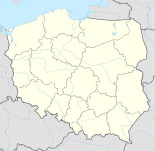Radzionków
| Radzionków | ||
|---|---|---|

|
|
|
| Basic data | ||
| State : | Poland | |
| Voivodeship : | Silesia | |
| Powiat : | Tarnowskie Góry | |
| Area : | 13.26 km² | |
| Geographic location : | 50 ° 23 ' N , 18 ° 53' E | |
| Residents : | 16,826 (Jun. 30, 2019) |
|
| Postal code : | 41-922 | |
| Telephone code : | (+48) 32 | |
| License plate : | STA | |
| Economy and Transport | ||
| Rail route : | Bytom – Tarnowskie Góry | |
| Next international airport : | Katowice | |
| Gmina | ||
| Gminatype: | Borough | |
| Residents: | 16,826 (Jun. 30, 2019) |
|
| Community number ( GUS ): | 2413031 | |
| Administration (as of 2007) | ||
| Mayor : | Gabriel Tobor | |
| Address: | ul.Męczenników Oświęcimia 42 41-922 Radzionków |
|
| Website : | www.radzionkow.pl | |
Radzionków [ raˈʥɔnkuf ] (German Radzionkau , in Silesia also Cidry ) is an industrial city with about 17,000 inhabitants in Poland . It is located seven kilometers north of Bytom ( Bytom ) in the Powiat Tarnogórski , Silesian Voivodeship .
history
The village of Radzionkau in the Beuthener Land, in which mining can be traced back to the Middle Ages , was a parish as early as 1326. The mention as a parish is the first written evidence of the place.
From the 18th century the place gained great importance through the mining of Galmeierz (zinc ore). The mining company Georg von Giesche's Erben subsequently became the largest company in the area. In 1868 Radzionkau, located in the Prussian district of Tarnowitz , was given a railway connection to Tarnowitz and Beuthen .
A coal mine called Radzionkau was also in operation between 1871 and 1877, and iron ore and limestone were also mined. Giesche built a zinc smelter in 1883 and a little later also a roasting plant for processing zinc blende .
In 1922 the place came to Poland .
Radzionków received town charter on July 28, 1951. On July 1, 1975, the city was incorporated into Bytom .
The mines in Radzionków were closed on December 31, 1996, the long mining tradition came to an end and 3,000 miners lost their jobs. Since then, the city's population has declined sharply.
On January 1, 1998, Radzionków regained its independence as a city.
Population development
|
traffic
The Radzionków station is located on the Chorzów – Tczew railway line and is the end point of the Chorzów – Radzionków railway line, which is no longer operated for passengers .
Culture
Deportation center
In 2015, a documentation center for the deportation of Upper Silesians for forced labor to the Soviet Union at the end of the Second World War was opened in the former train station . In addition to its exhibits, it offers interactive access.
Twin cities
- Dobre Miasto , Poland
- Boguszów-Gorce , Poland
sons and daughters of the town
- Paul Letocha (1834–1911), German lawyer and politician
- Paul Othma (1905–1969), German craftsman, victim of the dictatorship in the GDR
- Eugeniusz Juretzko (1939–2018), Polish religious, Roman Catholic bishop of Yokadouma in Cameroon
Web links
Individual evidence
- ↑ a b population. Size and Structure by Territorial Division. As of June 30, 2019. Główny Urząd Statystyczny (GUS) (PDF files; 0.99 MiB), accessed December 24, 2019 .
- ↑ for 2005; Główny Urząd Statystyczny, http://www.stat.gov.pl/dane_spol-gosp/ludnosc/stan_struk_teryt/2005/30_06/Tablica8.xls
- ↑ VDG: New book about deportations in Opole presented ( Memento of the original from July 31, 2017 in the Internet Archive ) Info: The archive link was inserted automatically and has not yet been checked. Please check the original and archive link according to the instructions and then remove this notice. ; 15th October 2014
